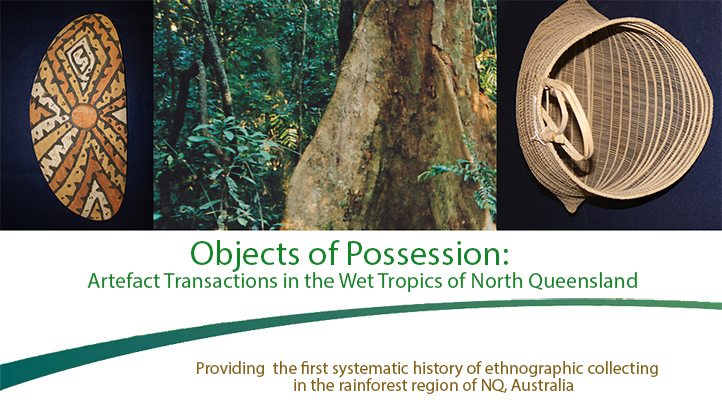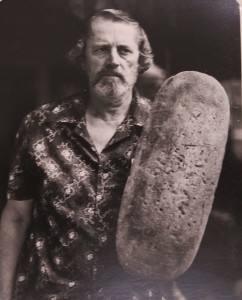Author: Trish Barnard
Collector: Frank Palmer Woolston
Born: Leichhardt (Petersham), Sydney, New South Wales, 1911.
Died: Maleny, Queensland, 1998
Active: Frank Woolston collected in the Wet Tropics region, mainly between Cardwell and Cooktown, from the1930s to the1990s.
Background biography:
Frank Palmer Woolston was an avid collector of Aboriginal artefacts, with a particularly keen interest in stone tools made by groups from the Wet Tropics area of North Queensland. He was born on 6 December 1911 at Leichhardt (Petersham) in Sydney, and named after his grandfather, confectioner William Palmer Woolston (1827 -1878). Frank was one of four children but his parents both passed away in 1923 when he was quite young. In his adult life, he became an optometrist and began working in Townsville with Stacey and Stacey in 1932, eventually becoming a partner in the firm with brothers John, Jim and Bill Gibson. During this period, he befriended many cane, banana and timber farmers and formed particularly strong relationships with the Jirrbal, Girramay and Gulnay people in the rainforest region around Cardwell and Tully. As an amateur anthropologist he began documenting their languages, diet and physical characteristics. In a 1973 article, Woolston compared these rainforest people to the historical photographs taken by Cairns photographer Alfred Atkinson in the 1890s, stating that ‘the people seem to vary considerably in stature and therefore we cannot say they were all small people’.
Not only did Woolston collect historical material culture uncovered by farmers ploughing their paddocks; he also purchased artefacts from an outlet at the Bellenden Homestead established by Gladys Henry to provide a modest income for the local Jirrbal, Girramay and Gulnay people and to enable them to maintain their ‘traditional’ skills. Woolston enthusiastically enquired about Aboriginal people, learning about their culture and how they made stone tools, shields, baskets and weapons from the resources in North Queensland’s Wet Tropics. He collected artefacts from Cooktown to Townsville, methodically documented each object and the site from which it was collected, and developed an informative catalogue of his collections.
In 1937 Woolston married Jean Francis and had a son Anthony. Two years later, with the outbreak of the Second World War, he enlisted in the Second Australian Imperial Force (service number Q217829) and together with his partner Jim Gibson cared for the optometric needs of locally-based Australian and American soldiers. In 1943 he was appointed to the rank of Lieutenant, but in 1948 he left the Army and returned to civilian life to continue optometry. He was living and practising optometry in North Queensland until 1949 when he moved to Brisbane to open a branch of Stacey and Stacey in Adelaide Street.
During his time in North Queensland he also formed a close friendship with pilot and explorer Percy J. Trezise (1923-2005), and fellow adventurer Doug Seaton. In 1965 Woolston accompanied Trezise on a trip to Mornington Island to film a documentary on traditional customs and ceremonies for the Australian Institute of Aboriginal Studies (now AIATSIS).
After his divorce, Woolston married Beryl Joy Kaddatz in 1956, and had three children, Kerrie, Mark and David. From the late 1950s to the early 1960s he also became a member of the Anthropological Society of Queensland, and was collecting Aboriginal material culture from many parts of Australia including artefacts from the Pitta Pitta people in western Queensland, as well as items from the Indigenous peoples of Stradbroke Island, Moreton Bay, Northern Territory, the Torres Strait Islands and Papua New Guinea. Woolston published articles in Mankind, Queensland Heritage and Queensland Naturalist, and delivered several papers at A.N.Z.A.A.S. congresses in the Anthropology Section. He also became an Associate Member of the Australian Institute of Aboriginal and Torres Strait Islander Studies (AIATSIS) in Canberra. During the early 1960s Woolston often returned to Cairns and joined Trezise on expeditions to remote areas around Laura, Jowalbinna and Deighton River in Cape York Peninsula. Working with traditional owners there, they recorded rock engravings and paintings.
While living in Brisbane, Woolston befriended fellow ethnography enthusiast and field naturalist Frederick Stanley Colliver though the Anthropological Society of Queensland. They travelled widely throughout Queensland, producing sound tapes, movie films, and reports for AIATSIS. Both men gained a credible reputation for their knowledge of Aboriginal material culture and the different cultural groups across Queensland. According to his wife Beryl, Woolston also held a role in the ‘Aboriginal Wardens Program’, a service provided by individuals or small groups who seek out Indigenous itinerants in the places they frequent. He travelled to Darwin and remote areas of Queensland, which provided him with opportunities to collect several hundred artefacts. His collection of morah stones, nut stones and ooyurkas from North Queensland, was purchased by James Cook University in 1991, and books from his collection are held in the JCU library at the Cairns campus.
Archaeologists Judith Field and her colleagues describe morahs as ‘a specialised type of grooved sedimentary rock grindstone used with a top stone. They are found only in the rainforests of north-eastern Queensland where the processing of toxic starchy plants is common and used in a “rolling crushing” motion rather than grinding’. Morahs have roughly parallel incised grooves running across the grinding surface perpendicular to the axis of the stone. Jirrbal elder Maisie Barlow has stated that these incised lines were made with sharp pieces of quartz across the softer slate stone. Morahs were used as a ‘grater’ to reduce seeds such as zamia (Lepidozamia hopei) or black bean (Castanospermum australe). Raw black beans are very poisonous so the toxins were leached from them to make them safe to eat. The black beans or seeds were grated and pounded into a coarse powder to make a type of damper or bread. In 1973 Woolston and Colliver described the upper pounding stones used with a grindstone as a ‘moogi’, the name given by an informant describing the use of morahs’. Moogi are usually fashioned out of granite, which is much harder than the slate of the morah stones. Ooyurkas are found only in the rainforests of northeast Queensland. They have a distinctive T-shape and parallel scratches or striations on the top edge. They were used to process rainforest foods. Russell Butler, a Banjin/Warrgamay Elder in Townsville, suggested that the edge of an ooyurka was used to grind a groove into an axe blank to assist in securing the handle.
Woolston died in 1998 from Guillain-Barre syndrome, and his ashes were placed beneath a lillipilli tree. His collection of morah stones, nut stones and ooyurkas from North Queensland constitutes one of the largest and most impressive assemblages of these items by one person. In 2003 the collection was split and a majority of items were transferred from the Material Culture Unit at JCU to the Queensland Museum. James Cook University Library’s Special Collections holds a large number of Woolston’s papers from the 1950s to the 1970s.
Sources:
Conversations between Beryl Woolston and Trish Barnard, March 2014.
Conversations between Russell Butler and Trish Barnard, Museum of Tropical Queensland, 2012.
Field, Judith, Cosgrove, Richard, Fullagar, Richard and Lance, Braddon, ‘Starch residues on grinding stones in private collections: a study of morahs from the tropical rainforests of NE Queensland’, in Archaeological science under a microscope: studies in residue and ancient DNA analysis’, in honour of Thomas H. Loy. http://press.anu.edu.au/wp-content/uploads/2011/08/17.pdf
F.P. (Frank) Woolston papers, JCU Library Archives, http://libserver.jcu.edu.au/specials/Archives/woolston.html
Woolston, F.P., ‘Some Material Culture of the North East Queensland Rainforest’, Archaeology Papers, Department of Aboriginal and Islander Advancement, 1973, No.14. http://espace.library.uq.edu.au/view/UQ:272909/Archaeology_papers_No14_Woolston_F_P.pdf
Woolston, F.P and Colliver, F. S., ‘Some Stone Artifacts from North Queensland rainforests’ in Occasional Papers in Anthropology of the Queensland University Anthropology Museum, 1973,Vol 1.

